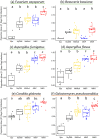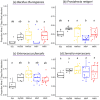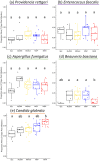This is a preprint.
A single amino acid polymorphism in natural Metchnikowin alleles of Drosophila results in systemic immunity and life history tradeoffs
- PMID: 36712113
- PMCID: PMC9882182
- DOI: 10.1101/2023.01.16.524277
A single amino acid polymorphism in natural Metchnikowin alleles of Drosophila results in systemic immunity and life history tradeoffs
Update in
-
A single amino acid polymorphism in natural Metchnikowin alleles of Drosophila results in systemic immunity and life history tradeoffs.PLoS Genet. 2024 Mar 11;20(3):e1011155. doi: 10.1371/journal.pgen.1011155. eCollection 2024 Mar. PLoS Genet. 2024. PMID: 38466751 Free PMC article.
Abstract
Antimicrobial peptides (AMPs) are at the interface of interactions between hosts and microbes and are therefore expected to be fast evolving in a coevolutionary arms race with pathogens. In contrast, previous work demonstrated that one AMP, Metchikowin (Mtk), has a single residue that segregates as either proline (P) or arginine (R) in populations of four different Drosophila species, some of which diverged more than 10 million years ago. The recurrent finding of this polymorphism regardless of geography or host species, coupled with evidence of balancing selection in Drosophila AMPs, suggest there is a distinct functional importance to each allele. The most likely hypotheses involve alleles having specificity to different pathogens or the more potent allele conferring a cost on the host. To assess their functional differences, we created D. melanogaster lines with the P allele, R allele, or Mtk null mutation using CRISPR/Cas9 genome editing. Here, we report results from experiments assessing the two hypotheses using these lines. In males, testing of systemic immune responses to a repertoire of bacteria and fungi demonstrated that the R allele performs as well or better than the P and null alleles with most infections. With some pathogens, however, females show results in contrast with males where Mtk alleles either do not contribute to survival or where the P allele outperforms the R allele. In addition, measurements of life history traits demonstrate that the R allele is more costly in the absence of infection for both sexes. These results provide strong in vivo evidence that differential fitness with or without infection and sex-based functional differences in alleles may be adaptive mechanisms of maintaining immune gene polymorphisms in contrast with expectations of rapid evolution. Therefore, a complex interplay of forces including pathogen species and host sex may lead to balancing selection for immune genotypes. Strikingly, this selection may act on even a single amino acid polymorphism in an AMP.
Figures






References
-
- Libert S., Chao Y., Chu X. & Pletcher S. D. Trade-offs between longevity and pathogen resistance in Drosophila melanogaster are mediated by NF κ B signaling. Aging cell 5, 533–543 (2006). - PubMed
-
- Lochmiller R. L. & Deerenberg C. Trade-offs in evolutionary immunology: just what is the cost of immunity? Oikos 88, 87–98 (2000).
Publication types
Grants and funding
LinkOut - more resources
Full Text Sources
